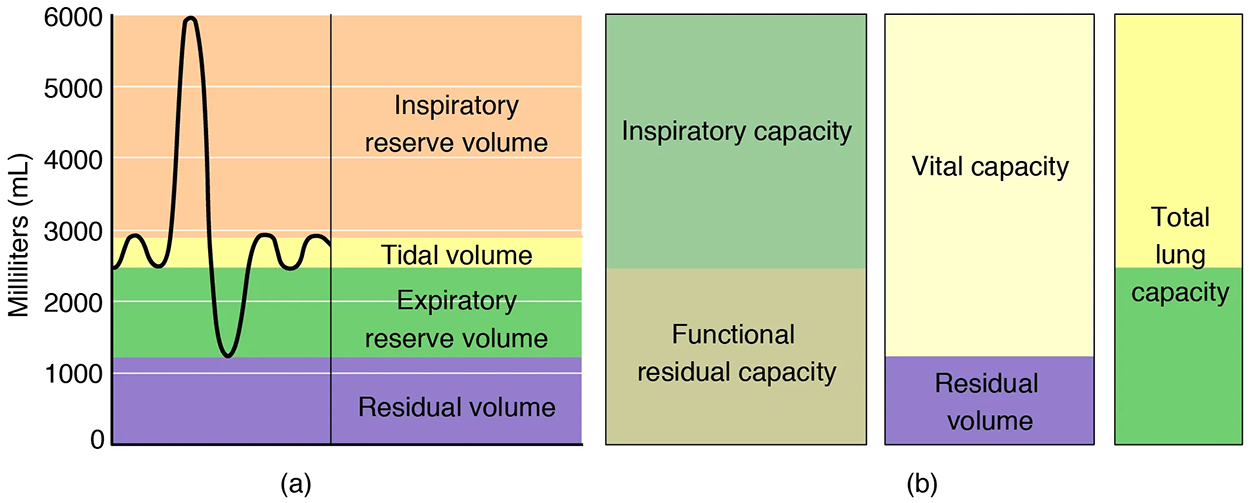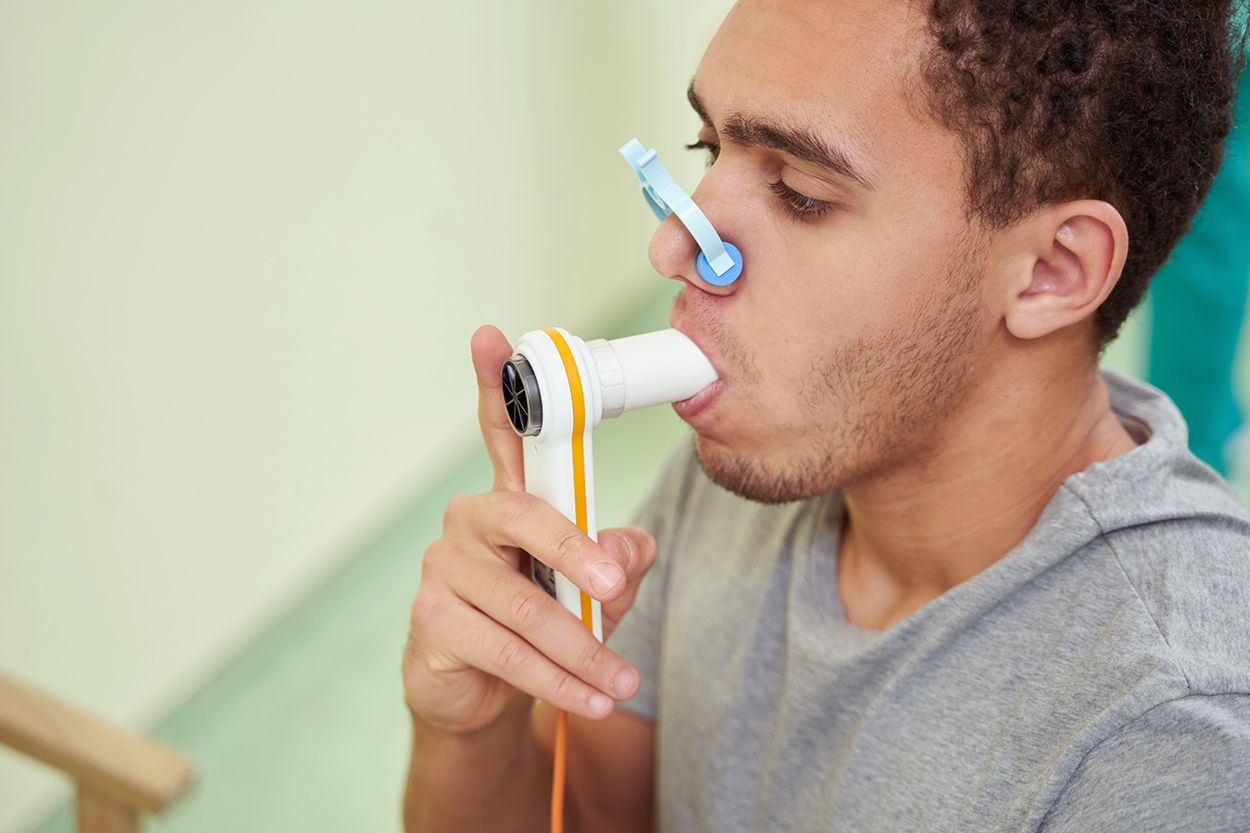Table of Contents |
Respiratory volume is the term used for various volumes of air moved by or associated with the lungs at a given point in the respiratory cycle. There are four major types of respiratory volumes: tidal, residual, inspiratory reserve, and expiratory reserve (see the image below).
Tidal volume (TV) is the amount of air that normally enters the lungs during quiet breathing, which is about 500 mL. Expiratory reserve volume (ERV) is the amount of air you can forcefully exhale past a normal tidal expiration, up to 1200 mL for males. Inspiratory reserve volume (IRV) is produced by a deep inhalation, past a tidal inspiration. This is the extra volume that can be brought into the lungs during a forced inspiration. Residual volume (RV) is the air left in the lungs if you exhale as much air as possible. The residual volume makes breathing easier by preventing the alveoli from collapsing.
Respiratory volume is dependent on a variety of factors, and measuring the different types of respiratory volumes can provide important clues about a person’s respiratory health.

| Pulmonary function test | Instrument | Measures | Function |
|---|---|---|---|
| Spirometry | Spirometer | Forced vital volume (FVC) | Volume of air that is exhaled after maximum inhalation |
| Forced expiratory volume (FEV) | Volume of air exhaled during one forced breath | ||
| Forced expiratory flow, 25-75% | Air flow in the middle of exhalation | ||
| Peak expiratory flow (PEF) | Rate of exhalation | ||
| Maximum voluntary ventilation (MVV) | Volume of air that can be inspired and expired in 1 minute | ||
| Slow vital capacity (SVC) | Volume of air that can be slowly exhaled after inhaling the past tidal volume | ||
| Total lung capacity (TLC) | Volume of air in the lungs after maximum expiration | ||
| Functional residual capacity (FRC) | Volume of air in the lungs after normal expiration | ||
| Residual volume (RV) | Volume of air in the lungs after maximum exhalation | ||
| Total lung capacity (TLC) | Maximum volume of air the lungs can hold | ||
| Expiratory reserve volume (ERV) | The volume of air that can be exhaled beyond normal exhalation | ||
| Gas diffusion | Blood gas analyzer | Arterial blood gasses | Concentration of oxygen and carbon dioxide in the blood |
Respiratory capacity is the combination of two or more selected volumes, which further describes the amount of air in the lungs during a given time. For example, total lung capacity (TLC) is the sum of all of the lung volumes (TV, ERV, IRV, and RV), which represents the total amount of air a person can hold in the lungs after a forceful inhalation. TLC is about 6,000 mL air for males and about 4,200 mL for females. Vital capacity (VC) is the amount of air a person can move into or out of their lungs, and is the sum of all of the volumes except residual volume (TV, ERV, and IRV), which is between 4,000 and 5,000 mL. Inspiratory capacity (IC) is the maximum amount of air that can be inhaled past a normal tidal expiration, it is the sum of the tidal volume and inspiratory reserve volume. On the other hand, the functional residual capacity (FRC) is the amount of air that remains in the lung after a normal tidal expiration; it is the sum of expiratory reserve volume and residual volume (see the image before the table above).
In addition to the air that creates respiratory volumes, the respiratory system also contains anatomical dead space, which is air that is present in the airway that never reaches the alveoli and therefore never participates in gas exchange. Alveolar dead space involves air found within alveoli that are unable to function, such as those affected by disease or abnormal blood flow. Total dead space is the anatomical dead space and alveolar dead space together and represents all of the air in the respiratory system that is not being used in the gas exchange process.
Lung volumes are measured by a technique called spirometry, which is a method that is used to both measure lung volumes and diagnose lung diseases. During a spirometry test, an individual breathes into a tube attached to a machine called a spirometer.

An important measurement taken during spirometry is the forced expiratory volume (FEV), which measures how much air can be forced out of the lung over a specific period, usually one second (FEV1). In addition, the forced vital capacity (FVC), which is the total amount of air that can be forcibly exhaled, is measured. The FVC, the ratio of these values (the FEV1/FVC ratio), and total lung capacity (TLC) are used to diagnose lung diseases including asthma, emphysema, and fibrosis. Normal FEV1/FVC ratios can vary with age and weight. Normal FEV1/FVC ratios are considered to be greater than 70% in adults and greater than 85% in children.
There are two categories of lung diseases:
| Measurement | Restrictive disease pattern | Obstructive disease pattern |
|---|---|---|
| FVC | Decreased | Decreased or normal |
| FEV1 | Decreased or normal | Decreased |
| FEV1/FVC ratio | Normal or increased | Decreased |
| TLC | Decreased | Normal or increased |
If the FVC is decreased, FEV1 is decreased or normal, FEV1/FVC ratio is normal or increased, and TLC is decreased, then this would indicate a restrictive pattern like pulmonary fibrosis where the lungs are not compliant (meaning they are stiff and unable to bend properly). Conversely, If the FVC is decreased or normal, FEV1 is decreased, FEV1/FVC ratio is decreased, and TLC is normal or increased then this would indicate an obstructive pattern such as asthma. In either case, breathing is difficult and complications arise.
IN CONTEXT
Career Connection
Respiratory Therapist
Respiratory therapists and respiratory care practitioners evaluate and treat patients with lung and cardiovascular diseases. They work as part of a medical team to develop treatment plans for patients. These individuals may treat premature babies with underdeveloped lungs, patients with chronic conditions such as asthma, or older patients suffering from lung diseases such as emphysema and chronic obstructive pulmonary disease (COPD). They may operate advanced equipment such as compressed gas delivery systems, ventilators, blood gas analyzers, and resuscitators.
There are specialized programs to become a respiratory therapist that generally lead to a bachelor’s degree with a respiratory therapist specialty. Because of the growing aging population, career opportunities as a respiratory therapist are expected to remain strong.
Source: THIS TUTORIAL HAS BEEN ADAPTED FROM (1) "ANATOMY AND PHYSIOLOGY 2E" ACCESS FOR FREE AT OPENSTAX.ORG/DETAILS/BOOKS/ANATOMY-AND-PHYSIOLOGY-2E. (2) "BIOLOGY 2E" ACCESS FOR FREE AT OPENSTAX.ORG/DETAILS/BOOKS/BIOLOGY-2E. LICENSING (1 & 2): CREATIVE COMMONS ATTRIBUTION 4.0 INTERNATIONAL